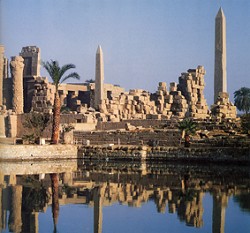
Area in the northeastern part of modern Luxor, taken up by a large complex of temples. They were part of the city of Thebes ('Waset' in ancient Egyptian), which was the religious capital of Egypt during great parts of its history. In 667 BC Thebes and the temple of Karnak were plundered by the Assyrian king Assurbanipal. Later on, the city was rebuilt a bit further to the south, close to the temple of Luxor. As a result, the remains of ancient Thebes lie to a great extent under modern Luxor. The temple complex consists of three separate areas, surrounded by walls, dedicated to Amun-Re, Mut and Montu. In addition to the temples dedicated to these gods there were also sanctuaries for other gods, such as Khons, Ptah, Osiris Hekadjet and Opet. There were perhaps already temples here in the Old Kingdom, but the oldest architectural remains date from the Middle Kingdom (Senwosret I). Virtually every king from then on improved and expanded the buildings, or added new ones. The first important additions date from the reign of Tuthmosis I, who not only constructed the 4th and 5th pylons but also erected two obelisks. Hatshepsut and Tuthmosis III also undertook important extensions, creating a second axis to the south leading towards the temple area of Mut, in addition to the east-west axis on which the original temple stood. In 1902, an important cache of thousands of statues was found under the floor of one of the courtyards on this axis. Other kings, such as Horemheb, Sethos I and Ramesses II made important additions to the temple, for example the huge hypostyle hall with 134 immense pillars. Amenhotep IV/Akhenaten built a temple to Re-Harakhty here, as well as several sanctuaries for the Aten; after the death of that king they were dismantled and the thousands of blocks, the so-called 'talatat', reused as filling for later constructions. Numerous large statues of the goddess Sakhmet erected by Amenhotep III were found in the forecourt of the temple of Mut. Nearby is the temple of Khons the Child, with scenes of the divine birth and circumcision (cf. also 'mammisi'). There was also a sacred lake which nowadays is crescent-shaped, called 'Isheru'.